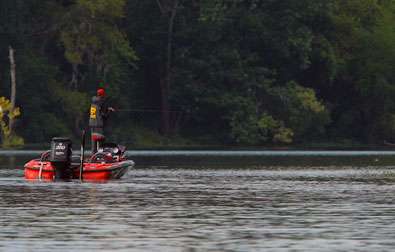
Most anglers consider power fishing techniques only when the bass are full of vigor and attacking everything in sight.
Not me. I power fish year-round — even in the early spring when the cold water chills bass' bones, lowers their metabolism and reduces their strike zone.
But that doesn't mean you can't catch them with crankbaits, jerkbaits and spinnerbaits that cover water faster and more thoroughly.
Admittedly, there are times when I catch fish with slower, finesse techniques in cold water, but it was power fishing techniques that helped me find those fish and dial in the pattern.
Power fishing is the foundation of everything I do. It makes me a more efficient angler by helping me locate and catch as many fish — big fish—— as I can in the shortest amount of time.
Of course, to be successful, you have to be in the area the bass are using. During early spring, that's going to be somewhere between the deep haunts where they winter and the bass' traditional spawning grounds.
One of the first places you'll find them is along dropoffs or deep weed edges that border the spawning flats. That gives bass immediate access to those flats when the water warms up and provides a safe haven if spring is delayed.
This is a time when boat position becomes as critical as lure/technique selection. When fishing those drops and edges, I position my boat parallel with the drops so that I can make optimum casts and keep my lure in the proper depth zone throughout the retrieve.
Because the water is cold, the bass are less likely to move far to take the bait. If you don't fish parallel, your bait catches a much smaller percentage of the key depth or area.
I retrieve the bait slower than I would during summer and probe all nearby depths along the dropoff until I determine the exact depth at which the fish live that day.
And, like I said, the cold water doesn't rule out action lures that do more than crawl seductively over the bottom.
I've discovered that bass are far more active in colder water than I once believed. Northern bass, more accustomed to colder water, will be more aggressive in lower temperatures than fish in Southern waters, but lure selection is a lot less relative to water temperature than most people realize.
Granted, the strike zone is smaller than it is in warmer water. Bass may not move as far to take a moving bait, but they will crush a power bait worked appropriately in their immediate area. And while the retrieve may be slower, it's still more efficient at covering water than finesse lures.
You have to match the lure/presentation with the conditions, too. Crankbaits and jerkbaits are two of best lures for this season, but I'm not opposed to snapping a tube or even jig off the bottom. That allows me to fish a more finesse pattern, yet fish a little faster than most anglers do with traditional finesse presentations.
As a rule, though, the Strike King Red Eye Shad, jerkbaits and crankbaits are my primary go-to lures. They not only cover a lot of water and depths but they feature a lot of inherent reaction qualities required to trigger the cold-water strike. You also can alter their actions by jerking, ripping or pausing them to interest neutral fish, too.
Water clarity also plays a role in lure/tactic selection this time of year. In stained water over grass, a Red Eye Shad or slow rolled spinnerbait can be good. In clear water, the jerkbait may be a better choice.
Changing weather conditions can be a factor, but keep in mind that cold-water bass respond similarly to weather changes as they do during warmer seasons. The strike zone is the largest on those cloudy, rainy frontal days when the wind is blowing. That's when I know I can move my lures faster.
However, on high pressure/no wind days I have to slow down and go to a bottom bouncing bait like a jig, tube or creature bait. I still fish it faster and erratically, but conditions require me to keep them near or on the bottom where the fish are.
A good example of how you can adjust to changing conditions happened to me at the 2008 Bassmaster Classic on Lake Hartwell. The weather was brutal the first competition day — temperatures were in the low 30s with wind, mist, and clouds — and I hammered the bass cranking a Strike King Series 5. The water was clear and the bass were suspended over 15-25 feet of water. I used a stop-and-start retrieve on a crankbait that I customized by adding weight to make it suspend. Although I was cranking it to get it down, I basically fished it like a jerkbait once I knew I was in the area where the fish were holding.
The next day conditions changed. The front passed and those fish would no longer come up and bite it in under sunny skies and in that clear water. I even tried bouncing a jig on the bottom with no success.
So I ran to the upper end of the lake where there was stained water and fished shallower with flat-sided crankbaits. The move saved the day for me — I caught 12 pounds in a couple of hours.
The difference? The bass in that dirtier water were on the bottom, relating to cover and channel swings, and therefore more aggressive.
Could I have caught them on slower, finesse tactics? Maybe. But I wouldn't have caught them in the short amount of time I had.
And that is how power fishing not only makes me more efficient, but helps me salvage a good day even when times are tough.
Next up: Power fishing the spawn and postspawn period.




